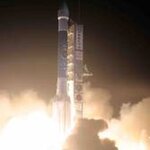Space

Our society is saturated with GPS, or Global Navigation Satellite System (GNSS), applications. GPS is the first GNSS and it is operated by US Air Force. Most people are not aware of the fact that GPS was developed and is run by the military. A reduced quality signal is released for civil use. After Europe decided to build their own GNSS, called Galileo, the US Air Force decided to released an improved signal. It was and is a matter of competition.
On August 17th 2009, the US Air Force launched the last satellite that will improve the GPS service even more. Again, I think this is a…

NASA scientists have discovered glycine, a fundamental building block of life, in samples of comet Wild 2 returned by NASA's Stardust spacecraft.
"Glycine is an amino acid used by living organisms to make proteins, and this is the first time an amino acid has been found in a comet," said Dr. Jamie Elsila of NASA's Goddard Space Flight Center in Greenbelt, Md. "Our discovery supports the theory that some of life's ingredients formed in space and were delivered to Earth long ago by meteorite and comet impacts."
Elsila is the lead author of a paper on this research accepted for publication in…

If you have never seen a fireball lighting up the night sky I bet you will appreciate the video below, which was taken by Ivaldo Cervini over Italian skies a few days ago. It is a Perseid meteor, which lit up at a visual magnitude of approximately -10 (for comparison, the brigthest Venus can get is -4.5, and the full moon is -12.5: -10 is roughly 200 times brighter than Venus, and a tenth of the full moon).
It is a quite rare occurrence to see such a bright meteor: in over a hundred hours of active observation of meteors, I only saw one which might be compared to the one above. Luckily,…

Planetary nebulae are gas and dust shells ejected by stars near the end of their lives - typically seen around stars comparable or smaller in size than the Sun.
The existing population of planetary nebulae is found around small stars comparable in size to our Sun but a new population discovered due to the presence of unusually strong radio sources may be the long predicted class of similar shells around heavier stars.
A team of scientists in Australia and the United States call the new class of object “Super Planetary Nebulae.” They report their work in the journal Monthly Notices of the…
The Gravity Recovery and Climate Experiment (GRACE) is a twin-satellite system to study in detail the Earth's gravity field. The GRACE data consist of accelerometer, GPS, and attitude measurements from each satellite plus the inter-satellite range change measurements. NASA says GRACE time-varying gravity signals measure seasonal variations in underground aquifers. A research team analyzed six years of GRACE gravity data for groundwater storage changes in northern India. The figure below illustrates how groundwater storage varied in that region from 2002…
Small bursts of heat and energy called nanoflares cause temperatures in the sun's atmosphere to reach millions of degrees, according to NASA researchers..
The sun's outer atmosphere, or corona, is made up of loops of hot gas that arch high above the surface. These loops are comprised of bundles of smaller, individual magnetic tubes or strands that can have temperatures reaching several million degrees Kelvin (K), even though the sun's surface is only 5,700 degrees K.
Nanoflares are small, sudden bursts of energy that happen within these thin magnetic tubes in the corona. Unlike solar flares,…
Tonight you have a chance to contribute to science -namely, the knowledge of our solar system- and have a lot of fun at the same time. Do you want to know how ? Then please read on.
Comet Swift-Tuttle (left, courtesy NASA) may be far away by now, but the debris that gets thrown out in space during each of its passages in the proximity of our Sun traces the full elliptical orbit of the comet, like droplets of sweat of an athlete running the 10,000 meters in a stadium. And tonight, the Earth is going to plunge in the core of the filament of debris following the comet's orbit.
Have you ever…

It's sharing time. Here's a cool space mashup map, titled "If extraterrestrial civilizations are monitoring our TV broadcasts, then this is what they are currently watching."
It's a plot of nearby stars, with lines indicating which TV show signals are just now reaching them. It's from Abstruse Goose, which is a new fav for me. Plus they have a free eBook of the first 100 comics. And their website is minimalist. Enjoy!
Conceptually, it's an elegant mashup. Take a star map, which has distances to nearby stars in light-years (distance light travels in one year…

There are many hypotheses about the early days of black holes. Researchers writing in The Astrophysical Journal Letters have undertaken simulations using data taken from observations of the cosmic background radiation—the earliest view of the structure of the universe - and then applied the basic laws that govern the interaction of matter. In doing so, they say they have allowed the early universe in their simulation to evolve as they believe it did in reality.
Astrophysicists Marcelo Alvarez and Tom Abel of the Kavli Institute for Particle Astrophysics and Cosmology, jointly…

Amateur astronomers fond of visual observation of faint galaxies and other fuzzy treasures of the night sky are always in search of the best observative site, where to drag their large Dobsonian telescopes.
Unfortunately, their road is always uphill - also in a metaphorical sense: light pollution is growing everywhere at a disturbing rate, and it has already erased all but the brightest stars from our urban and suburban skies.
Many of our kids grow without having seen the Milky Way, and the few who are drawn to astronomy are surprised to realize, from the tales of older dogs like me, that it…